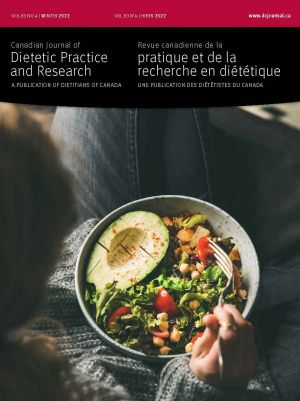Abstract
Purpose: Explore Canadians’ dietary intake in relation to the 2019 Canada’s Food Guide (CFG) Plate using novel volume-based food analyses, by age and meal occasion.
Methods: Foods reported in 24-hour recalls by 20,456 Canadians in the 2015 Canadian Community Health Survey – Nutrition were classified as: Vegetables and Fruits, Whole Grain Foods, Protein Foods, Non-Whole Grain Foods or Other Foods (high in fat, sugar, sodium). Food volumes were used to calculate percent contributions of each grouping to total intake, stratified by age (1–6; 7–12; 13–17; 18–64; 65+years) and meal (breakfast, lunch, supper, snack), applying sample survey weights and bootstrapping.
Results: By volume, the Canadian population diet included: 29% Vegetables and Fruits, 22% Protein Foods, 7% Whole Grains, 24% Non-Whole Grain Foods, and 18% Other Foods. Intakes of Protein Foods (1–6 years) and Other Foods (7–12; 13–17 years) were higher in children than adults by volume, relative to total intake. Whole Grains intake was highest at breakfast. Other Foods intake was highest at snack.
Conclusions: The volume-based population diet of Canadians reported on a single day includes a substantial proportion of non-recommended foods. There are opportunities to design interventions that target specific foods, ages, and meals to align intake with recommendations.
Résumé
Objectif. Comparer l’apport alimentaire des Canadiens à l’assiette du Guide alimentaire canadien (GAC) de 2019 à l’aide d’analyses alimentaires novatrices fondées sur le volume et en fonction de l’âge et du type de repas.
Méthodes. Les aliments rapportés dans des rappels de 24 heures de 20 456 Canadiens lors de l’Enquête sur la santé dans les collectivités canadiennes – Nutrition de 2015 ont été classifiés comme suit : légumes et fruits, aliments à grains entiers, aliments protéinés, aliments non à grains entiers ou autres aliments (riches en gras, sucre et sodium). Les volumes d’aliments ont été utilisés pour calculer le pourcentage de contribution de chaque groupe à l’apport total, puis stratifiés par âge (1-6; 7-12; 13-17; 18-64; 65 et plus) et type de repas (déjeuner, dîner, souper, collation), en appliquant des pondérations à l’échantillon et en utilisant la méthode d’autoamorçage.
Résultats. Sur la base du volume, l’alimentation de la population canadienne incluait : 29 % de légumes et fruits, 22 % d’aliments protéinés, 7 % de grains entiers, 24 % d’aliments non à grains entiers et 18 % d’autres aliments. L’apport en aliments protéinés (1-6 ans) et autres aliments (7-12; 13-17 ans) était plus élevé chez les enfants que chez les adultes sur la base du volume, relativement à l’apport total. L’apport en grains entiers était le plus élevé au déjeuner. L’apport en autres aliments était le plus élevé à la collation.
Conclusions. Sur la base du volume, l’alimentation de la population canadienne rapportée au cours d’une seule journée inclut une proportion substantielle d’aliments non recommandés. Il existe des occasions de concevoir des interventions ciblant des aliments, âges et repas qui permettraient de faire cadrer les apports aux recommandations.



